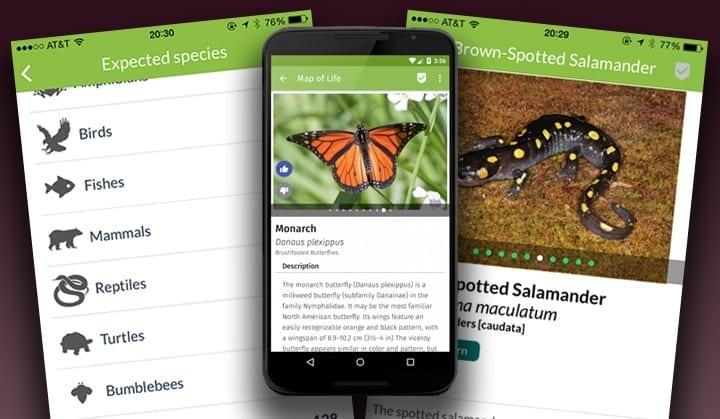
People can check out local wildlife wherever they are in the world with a new app that says what species of animals and plants might be nearby.
The free Map of Life app dispenses with bulky field guides by allowing users to access a vast global database of species and their ranges, based on their location.
Building on the Map of Life website, which provides a database of everything from bumblebees to trees, the app tells users in an instant which sets of species are likely to be found in their vicinity. Photos and text help users identify and learn more about what they see. The app also helps users create personal lists of observations and contribute those observations to scientific research and conservation efforts.
“The app puts a significant proportion of our global knowledge about biodiversity in the palm of your hand, and allows you to discover and connect with biodiversity in a place, wherever you are,” said guiding force behind the Map of Life Professor Walter Jetz, a Senior Scientist in the Grand Challenges in Ecosystems and Environment group at Imperial College London and an associate professor at Yale University.
“This vast information, personalized for where we are, can change the way we identify and learn about the things we see when traveling, hiking in the woods, or stepping in our own back yard.”
Instead of sifting through hundreds of pages in a printed field guide, naturalists get a digital guide that is already tailored to their location. With a novel modelling and mapping platform covering tens of thousands of species — everything from mammals and birds to plants, amphibians, reptiles, arthropod groups, and fish — Map of Life presents localised species information via maps, photographs, and detailed information.
Thanks to a recording feature, citizen scientists everywhere can log their bird encounters and dragonfly sightings directly into the app and add to the biodiversity data available to scientists around the world.
“Think of a field guide that continues to improve the more we all use it and add to it. That is the beauty of this mobile application, and its great strength,” said Rob Guralnick, associate curator at the University of Florida and the project’s co-leader. “Built from 100 years of knowledge about where species are found, we hope to accelerate our ability to completely close the many gaps in our biodiversity knowledge.”
Indeed, making it easier and more globally streamlined for citizen scientists to contribute information is one of the key motivations behind creating the app. “The world is changing rapidly and species continue to disappear before we even knew where they occurred, what role they had, and how we could conserve them,” said Professor Jetz, who is involved in several global science initiatives for advancing biodiversity monitoring.
“Too much of our knowledge is limited to too few places and species,” said Professor Jetz. “Helping people everywhere to identify and then record biodiversity carries the potential to hugely extend the geographic and taxonomic reach of measuring the pulse of life.”
Read more: New app puts the world’s biodiversity in the palm of your hand
The Latest on: Map of Life
[google_news title=”” keyword=”Map of Life” num_posts=”10″ blurb_length=”0″ show_thumb=”left”]
via Google News
The Latest on: Map of Life
- Cicada map 2024: See where to find Brood XIX and XIII − and where they've already been spottedon May 7, 2024 at 12:01 am
Broods XIX and XIII have not emerged together since 1803, and after this year, won't emerge together again until 2245. While they are largely in different states, they are both emerging in parts of ...
- We have some notes about John Mulaney’s map of L.A.on May 6, 2024 at 3:25 pm
The stand-up’s hilarious, limited-run talk show on Netflix makes a few mix-ups with L.A.’s geography—but so too do Angelenos.
- Why Venus May Be Our Best Bet For Finding Life In the Solar Systemon May 6, 2024 at 4:01 am
Recent research has raised the tantalizing prospect that our Solar System, in which we thought we were alone, may be dotted with diverse, and deeply weird, homes for life.
- Cicada map 2024: Latest on Broods XIII and XIX as sightings are reported across the Southon May 1, 2024 at 1:08 am
Both Broods XIX and XIII will emerge this year, but conditions are already right in some areas for the periodical insect to come out.
- How maps are used and abused in times of conflicton April 29, 2024 at 8:46 am
Maps, although seemingly objective representations of the world, hold immense power. They shape our understanding of space, navigate our journeys and define political boundaries. But beneath the ...
- Global study maps most detailed tree of life yet for flowering plantson April 24, 2024 at 8:34 am
After the first flower bloomed on the Earth, flowering plants evolved a staggering diversity and now make up about 90% of all plant life. Charles Darwin called this rapid domination an “abominable ...
- Researchers map structure of mitochondria at different life stageson April 7, 2024 at 5:00 pm
developed a quantitative 3D electron microscopy approach to map cristae network organization in the BAT of adult and aged mice. The researchers' findings, published in Advanced Biology under the ...
- 12 Genius Google Maps Settings That’ll Make Your Life Easieron February 14, 2024 at 8:49 pm
But are you fully taking advantage of the Google Maps settings that'll make your life infinitely easier? The tool offers so much more than just driving directions, a snapshot of where you've been ...
- Scientists have published a new map of life, the universe and everything. Well, some of it.on January 30, 2023 at 4:00 pm
And the map doesn't go to the very edges of the universe, because the universe, as you may have heard, is infinite. And the map isn't of how the universe is now, but of how it looked billions and ...
- New Biodiversity Map Offers View of Life on Both Land and Wateron February 4, 2020 at 4:00 pm
allowing scientists to determine the most important factors that allow life to thrive in one place versus another. "Previous biodiversity maps show either land or sea with the other area grayed out,” ...
via Bing News










